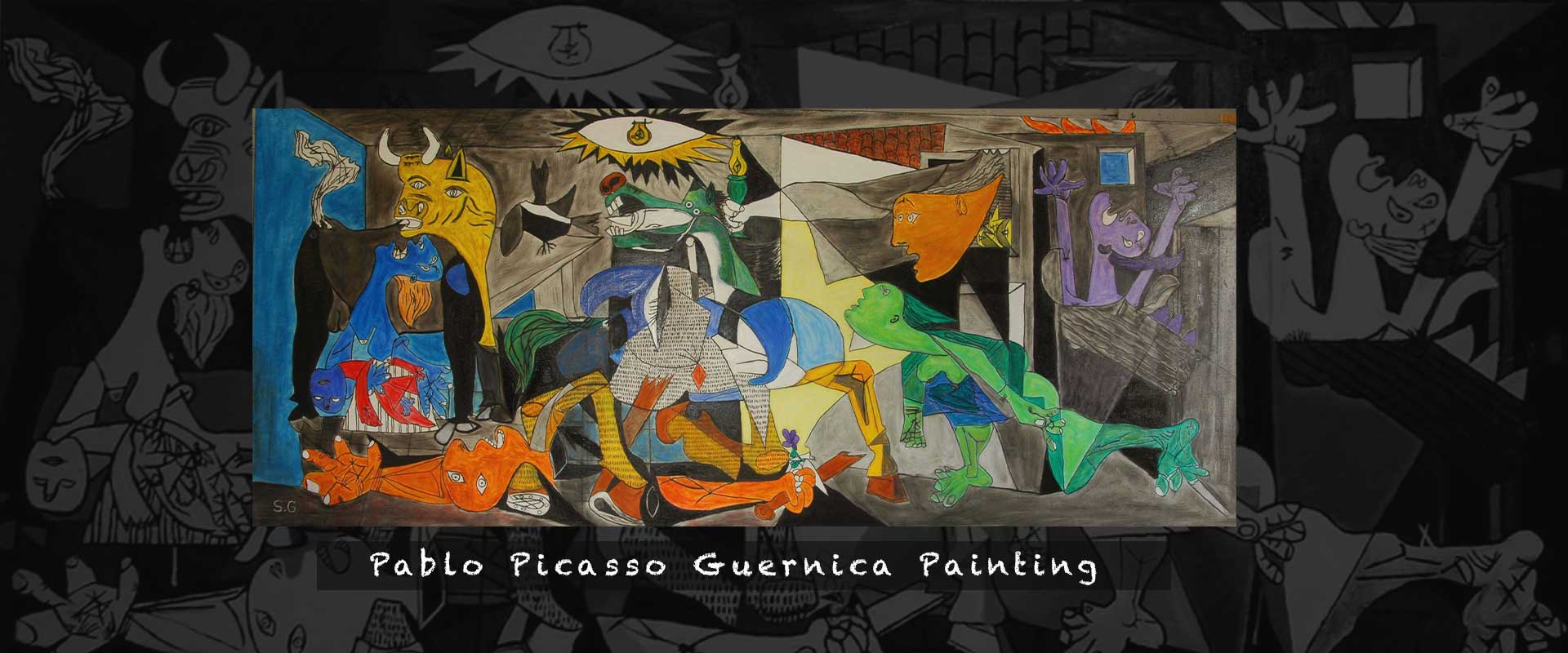The Pablo Picasso Guernica painting is more than a work of art—it is a visual manifesto against violence and oppression. Created in 1937 in response to the bombing of the Basque town of Guernica during the Spanish Civil War, this monumental black-and-white canvas has become one of the most iconic anti-war images in history.
Through its fragmented forms, symbolic figures, and stark palette, Guernica forces viewers to confront the chaos of modern conflict. This visual analysis will explore how Picasso’s artistic language—rooted in Cubism but charged with emotional urgency—transforms tragedy into a universal statement.
The Historical Spark of Guernica
The bombing of Guernica by German and Italian warplanes on April 26, 1937 left hundreds of civilians dead and shocked the world. Picasso, then living in Paris, had been commissioned to produce a mural for the Spanish Pavilion at the Paris World’s Fair. The tragedy provided his subject, and within weeks, he completed a painting that would resonate far beyond Spain.
As discussed in Guernica by Pablo Picasso: The Meaning Behind the Masterpiece, this canvas is both a memorial and a cry of protest.
Composition and Structure
Guernica is massive—over 25 feet wide and 11 feet tall—designed to overwhelm the viewer. Its composition is structured yet chaotic, mimicking the disorientation of violence.
- Triangular Layout: Central to the painting is the anguished horse, forming a dynamic triangle with the bull on the left and the woman with a lamp on the right.
- Overlapping Figures: Multiple characters collide in fractured perspectives, a hallmark of Picasso’s Cubist language.
- Light and Dark Contrasts: The interplay of black, white, and gray creates intensity while evoking the documentary realism of newspaper photos.
The painting’s sheer size and fractured design force the viewer to move across it, piecing together meaning from chaos.
Symbolism in the Figures
The symbols of the Guernica painting carry both personal and cultural meanings:
- The Bull: Often read as a symbol of brutality or Franco’s fascism, though some argue it represents endurance.
- The Horse: Central and screaming, pierced by a spear-like form, symbolizing the people’s suffering.
- The Grieving Mother: Holding her dead child, her twisted face echoes Catholic pietà imagery.
- The Fallen Soldier: Broken on the ground, clutching a shattered sword, yet a flower sprouts from his hand—fragile hope amid devastation.
- The Light Bulb (Eye of God): Suspended above, simultaneously a technological horror and a symbol of judgment.
- The Woman with the Lamp: Emerging with a candle, she provides a flicker of resilience within the darkness.
As highlighted in Picasso Guernica Painting: The Symbols You Might Have Missed, hidden details like a skull in the horse’s nose deepen the painting’s impact.
Visual Language of Guernica
- Fragmented Cubist forms mimic the shattered reality of war.
- Stark monochrome palette reflects newspaper reportage.
- Figures are distorted into raw expressions of grief and terror.
- Scale forces the viewer into physical confrontation with tragedy.
- Lack of horizon or setting suggests a universal, timeless space.
These elements ensure Guernica remains as emotionally powerful today as when it was unveiled.
Comparison: Guernica vs Other Picasso Works
| Work | Year | Theme | Visual Language | Legacy |
|---|---|---|---|---|
| The Old Guitarist | 1903 | Poverty, sorrow | Elongated Blue Period figure | Human empathy |
| Les Demoiselles d’Avignon | 1907 | Modernity, fragmentation | Proto-Cubism, multiple perspectives | Birth of modern art |
| Guernica | 1937 | War, human suffering | Monumental, black & white, symbolic chaos | Universal anti-war symbol |
| Weeping Woman | 1937 | Personal grief | Bold colors, distorted features | Companion to Guernica |
This shows how Guernica marks the moment Picasso’s art became overtly political while still carrying forward his Cubist innovations.
Global Impact of the Visual Message
Political Resonance
Since its unveiling, Guernica has been displayed as a banner for peace and protest. It traveled across Europe and America to raise awareness of Spain’s suffering and later became a rallying symbol against wars worldwide.
Influence on Artists
Generations of artists have drawn inspiration from its symbolic language and monumental scale. From muralists like Diego Rivera to abstract painters like Jackson Pollock, Guernica demonstrated how modernism could carry political weight.
Contemporary Presence
Even today, reproductions of Guernica appear in protests and exhibitions, reminding audiences of the timeless relevance of its visual symbols. As analyzed in Pablo Picasso Art: How He Shaped the 20th Century, it remains one of the most defining works of modern art.
Why Guernica Endures
- Universality: Its imagery applies to all wars, not just Spain’s Civil War.
- Ambiguity: Open to multiple interpretations, ensuring continued debate.
- Accessibility: Its stark visuals communicate across language and culture.
- Moral Authority: It transformed art into a voice of conscience.
Conclusion
The Pablo Picasso Guernica painting is a monumental act of visual protest. Through fragmented forms, symbolic imagery, and emotional intensity, Picasso captured both the specific tragedy of Guernica and the universal horrors of war. It is a work that overwhelms, unsettles, and inspires—an example of how art can serve as both history and prophecy. More than eighty years later, Guernica remains one of the most important visual statements of human resilience and resistance.
FAQs on Pablo Picasso Guernica Painting
What does the Pablo Picasso Guernica painting represent?
It represents the horrors of war, focusing on civilian suffering during the Spanish Civil War, while symbolizing universal human tragedy.
Why is Guernica painted in black and white?
Picasso chose monochrome to mimic newspaper photos and strip away distractions, emphasizing raw emotional impact.
What symbols are in the Guernica painting?
The bull, horse, grieving mother, fallen soldier, light bulb, and woman with lamp are central, alongside hidden images like a skull.
How large is Guernica?
It measures approximately 11.5 feet tall and 25.6 feet wide, making it one of Picasso’s largest works.
Where is Guernica displayed today?
Guernica is housed at the Museo Reina Sofía in Madrid, Spain’s leading modern art museum.





